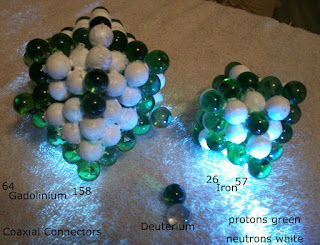Announcing a discovery of the shape of the nucleus of iron. On May 25, 2017 a theory was discovered which shows that magnetism is caused by the protons in iron making a specific shape. Iron has a nucleus with two loops of protons that are coaxial with isolated protons. Each loop of protons carries superconducting proton current. A North pole is made by a clockwise current in 12 protons, as seen from the center of the nucleus. Reversing the view from the center, a South pole is seen as a counter-clockwise current in the other 12 protons. Above the Curie temperature, electron motion is coupled to the proton currents so much that interference between wavefunctions destroys the harmonious superconducting state. The ring currents change, independently for each ring from the other ring.
Calculus was discovered independently by Leibniz and Newton. They produced the calculus, they developed it, they discovered it, like Folmsbee discovered the correct description of the shape of the iron nucleus. Once one element was correctly described, all other elements used the same Rules to have their shapes and charge distributions described. See the 2022 book, Charge distributions on the nuclei, from Amazon.
See the article in The Journal of Nuclear Physics, March, 2019
"Magnetism from iron's nuclear structure"
See nuclear-data.com from 2024
See the article in The Journal of Nuclear Physics, March, 2019
"Magnetism from iron's nuclear structure"
See nuclear-data.com from 2024
Cobalt also has two loops, each with 12 protons. There are 4 ferromagnetic elements.
Nickel and Gadolinium are ferromagnetic and those elements show the loops.
Gadolinium's nucleus is based on Cerium. Gd has 18 protons in each ring of protons. The theory is called the Static Nucleus Theory of the Face-Armored Cubic Lattice.
Here is a link to a paper describing an iron atom under a microscope. The iron atom has a triangular shape when seen alone on a substrate of molybdenum sulphide.
That triangle is for a North pole. The South pole has another triangle. The six tips of the poles are due to the nucleus having six faces on a cubic lattice, as part of its nuclear structure. Six piles of protons and neutrons (baryons) cover each face of the cube. The six tips of proton groups cause the six vertex's of the iron atom to be shaped as triangles.
Models of two nuclei are shown next. Protons are green and neutrons are white.
Figure 1: Two Nuclei, Gd, Fe
Gadolinium is ferromagnetic because it has two rings of protons that are coaxial. When a clockwise current flows in one ring of protons and a counter-clockwise superconducting current flows in the second ring of protons, then the atom is de-magnetized. For nonferrous elements: If the ring of protons has a triangular shape, like iron, but each corner of the triangle points inwards to the nucleus, then the current does not flow with a superconducting property. Elements with the ferromagnetic property all have rings made with six lines which six vertices. Those vertices make angles that point in directions that are tangential to the nucleus, or away from it. The wavefunction of a superconducting proton current will not interfere with adjacent current segments when that ring shape is in place for the nucleons of a chemical element. But non-ferrous elements have proton rings that direct the current into the interior of the nucleus, where wavefunction interference is likely to occur. For example, cadmium has two coaxial rings of protons and is nonferrous. Zirconium also has two rings of protons and it is nonferrous because of the internalization of ring current flow directions. The theory is that ferromagnetic elements do not direct the ring currents into the interior of the nucleus. The electrons are connected to the protons, so an unobstructed path from the protons to the electrons seems to be a requirement for ferromegnetic elements. That means no internalizations of current directions is created by the nuclear structure. 3/17/2023 Alan Folmsbee
Cubic Hexapyramid
Element 64
Atomic weight 158
Figure 2 Iron and Cerium are perfect cubic hexapyramids
Figure 2 shows the internal construction of cerium: it is a tetra-hexahedron, or pyramidal cube. Gadolinium is like Ce but with 6 more protons. That makes element 64
have two loops of protons, coaxial with isolated protons. That is like a
coaxial connector, or a lens, or transformer. Ferromagnetism is caused by
the two loops in the coaxial perfection of Iron.
coaxial connector, or a lens, or transformer. Ferromagnetism is caused by
the two loops in the coaxial perfection of Iron.
Figure 3: Protons can touch each other
which just add protons on the exterior.
Figure 4: Inside the cubic hexapyramid of a Cerium nuclear fragment
Figure 5: Non-ferrous Copper and Manganese have defective loops
Links
2018 Nihonium nucleus : https://impuremath.wordpress.com/2017 summer periodic table: http://pyramidalcube.blogspot.com/2017/08/periodic-table-of-shapes-of-nuclei.html
2017 spring iron 2 loops : http://ferronuclear.blogspot.com/p/uranium.html
2016 gravito-Maxwell : http://traction8d.blogspot.com/p/iron-56_30.html
2015 5ns constant : http://fcontinuumgravity.blogspot.com/p/research-planning.html
2014 gravity : http://fcgravity.blogspot.com/
October 16, 2014 began the discoveries by Alan Folmsbee
June 21, 2017






I haven't taken the time to work through your material yet but, at first glance it is extremely interesting for a few reasons. My key interest has been cubic geometr and cubic structures related to to atoms and molecules. It is interesting to see that reflected here. I have found that cubes and spheres are the natural extremes of the shapes that energy adopts and that special conditions, such a highly magnetic resonance, result from specific combinations of these shapes and related geometries. I look forward to having a closer look at your work.
ReplyDeleteDear Andy,
DeletePlease look at my paper in The Journal of Nuclear Physics,
http://www.journal-of-nuclear-physics.com/?m=201903
"Magnetism from iron's nuclear structure"
March, 2019 issue